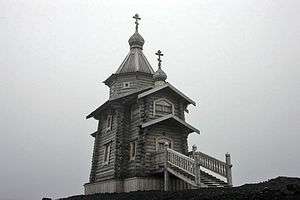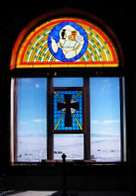Religion in Antarctica
Antarctica has various places of worship and an increasing demand for religious services and construction of sacred architecture on the continent. In spite of the famous saying "below 40 degrees south there is no law; below 50 degrees south there is no God"[1] the exploration of the continent was in fact closely connected to religious activities with contributions from many adherents (e.g. Jesuit geophysicists). Some of the early religious buildings are now protected as important historical monuments.
Beginnings

A cross on Wind Vane Hill, Cape Evans, was erected by the Ross Sea Party, led by Captain Aeneas Mackintosh, of Sir Ernest Shackleton’s Imperial Trans-Antarctic Expedition of 1914–1917, in memory of three members of the party who died in the vicinity in 1916. The cross has been designated a Historic Site or Monument (HSM 17), following a proposal by New Zealand and the United Kingdom to the Antarctic Treaty Consultative Meeting.[2]
The first complete religious service in Antarctica was performed in 1947 by William Menster (1913–2007), Lieutenant Commander of the United States Navy during Operation Highjump.[3] During a Christian service held in a tent set up on land, he consecrated Antarctica. Ministering to approximately 2,000 men from a variety of Christian denominations gave him experience in leading ecumenical services.
Although they are used mostly for Christian worship, the Chapel of the Snows has also been used for Buddhist and Bahai ceremonies. Some of the buildings are among historically important sites and under protection, such as the Chilean Captain Arturo Prat Base's wooden cross and a Statue of Our Lady of the Carmel.[4] While the Pakistan program at Jinnah Antarctic Station brought Muslims to Antarctica, there are currently no mosques on the continent or on any of the outlying islands, as the most optimal ways of observing Islamic religious customs there are still being determined.
History (including the subantarctic islands)

Around 1900, whaling stations and expedition camps were erected in the larger area. After World War II, some military expeditions explored the region. The International Geophysical Year (1957–1958) marked the end of a long period during the Cold War when scientific interchange between East and West had been seriously interrupted and has since contributed to civil scientific exploration. Since the 1950s, most stations in Antarctica have been constructed exclusively for scientific research. Extended stays in the region can be an extremely stressful experience for the researchers who often have been separated from their families for months at a time.[5] Jesuits, which have had a long tradition of geophysical research in Antarctica, contributed as well to the early Antarctic missions. Notable Jesuit seismicity scholars like Edward A. Bradley (compare Bradley Nunatak), Henry F. Birkenhauer (compare Birkenhauer Island) and J. Joseph Lynch and Daniel J. Linehan have been among those.[6]
The first churches south of the Antarctic Convergence and north of 60° S latitude (and thus not part of the Antarctic Treaty System) are Notre-Dame des Vents at Port-aux-Français on the main island of Kerguelen and the Norwegian Lutheran Church (Grytviken, South Georgia), a Lutheran chapel in Grytviken, South Georgia (since 1913). After years of abandonment and weathering the harsh elements of the region (roof damaged in 1994), the Grytviken church was renovated by the keepers of South Georgia Museum and volunteers in 1996–1998 and now serves for occasional church services and marriage ceremonies.[7]
Some churches north of the Antarctic Convergence serve Antarctic territories, such as the Christ Church Cathedral in Stanley, which is the southernmost Anglican cathedral in the world. It serves as the parish church not only for the Falkland Islands, but also South Georgia and the British Antarctic Territory. Punta Arenas in the southern tip of the South American mainland (just north of Tierra del Fuego) also has a Roman Catholic cathedral, which serves the Chilean Antarctic Territory.
Christians have increasingly turned toward Internet communications for fellowship in the 21st century.[8]
Notable buildings

Out of nearly 90 stations in Antarctica, half are only used in summer months. Most research stations have a small meeting room dual-purposed for religious assemblies.[9] Larger stations and communities use a separate room, often a makeshift steel container for religious purposes.[9]
The Worldwide Antarctic Program proposes building a Catholic chapel at Mario Zucchelli Station, Terra Nova Bay, Antarctica; while the first Catholic chapel (named after Saint Francis of Assisi) was built in 1976 at the Argentine Esperanza Base.[10] The southernmost Christian chapel (in fact, the southernmost place of worship of any religion) lies at the Argentine Belgrano II Base at Coats Land.[11] It is a permanent Catholic chapel made entirely of ice.[12] The Chapel of the Snows was erected in 1956 as a Christian chapel used by several denominations, at McMurdo Station, Ross Island. The Chapel offers various Protestant and Catholic services, but also allows for meetings of other religions, such as Latter Day Saints, Bahai and Buddhists and is used as well for secular groups (e.g. Alcoholics Anonymous). The chapel had been rebuilt after a fire in 1978 and was reconsecrated in 1989. Further dedicated religious buildings are the Chapel of Santisima Virgen de Lujan, Antarctica, a Catholic chapel at Marambio Base, Seymour Island, San Francisco de Asis Chapel, a Catholic chapel at Esperanza Base, Antarctic Peninsula and Santa Maria Reina de la Paz Church, a Catholic church at the Villa Las Estrellas, South Shetland Islands. Santa María Reina de la Paz is a repurposed container allowing for 36 persons to convene.[13]
Eastern Orthodox Christian revival

Religious activities were halted during the Soviet Antarctic Expedition. However, this changed with the fall of the Soviet Union and the Communism within Central and Eastern Europe.
The St. Ivan Rilski Chapel, a Bulgarian Orthodox chapel at St. Kliment Ohridski Base, South Shetland Islands was built in 2003 and is the first Eastern Orthodox edifice in Antarctica, and was the southernmost Eastern Orthodox building of worship in the world till 2011 when St Volodymyr (Vladimir the Great) Chapel at Ukrainian Vernadsky Research Base was erected.
The Buromsky Island cemetery belongs among the most important monuments in the region.[14] A Russian orthodox cross has been erected in the meanwhile to mark the site. The island holds a cemetery for about 60 citizens of the Soviet Union, Czechoslovakia, the German Democratic Republic and Switzerland who died in the performance of their duties while serving as members of Soviet and Russian Antarctic expeditions. It has been designated a Historic Site or Monument (HSM 9) following a proposal by Russia to the Antarctic Treaty Consultative Meeting.[2]
In 2002 Patriarch Alexy II of Moscow asked for a "Temple for Antarctica" (Храм Антарктиде) and initiated the Trinity Church, Antarctica, a Russian Orthodox church at Bellingshausen Station, South Shetland Islands.[15][16] The Church is being positioned as a widely visible landmark[9] and is maintained by the Moscow Patriarch.[17] It was first maintained by a single priest. In the meanwhile two priests maintain the services, which are being exchanged annually. They both contribute to the maintenance of the overall station.[18] January 29, 2007 saw the first church wedding on Antarctica, between a Chilean and Russian.[18][19] The first baptism (for adults) also took place there.[20]
Notes
- ↑ Melinda Mueller: What the Ice Gets: Shackleton's Antarctic Expedition 1914–1916, Van West & Co., 2000, ISBN 0-9677021-1-9
- 1 2 "List of Historic Sites and Monuments approved by the ATCM (2012)" (PDF). Antarctic Treaty Secretariat. 2012. Retrieved 2013-10-25.
- ↑ William Menster, Strong Men South, 1949 Bruce Pub. Co. Milwaukee
- ↑ HSM 35: Virgin of Carmen Statue in Antarctic Protected Areas Database)
- ↑ Compare Geology and Religion: A History of Harmony and Hostility, Martina Kölbl-Ebert, S. 142, Geological Society, 2009
- ↑ William H.K. Lee, Paul Jennings, Carl Kisslinger, Hiroo Kanamori: International Handbook of Earthquake & Engineering Seismology, Teil 1, Academic Press, 27. September 2002, S. 24, ISBN 0-12-440652-1 (, p. 24, at Google Books)
- ↑ "Grytviken Church (Whalers Church)". Wondermondo.
- ↑ "Priests No Longer Needed as Digital Antarctica Embraces Online Religion". The Guardian. Guardian Media Group, syndicated by Australian Associated Press. July 23, 2015.
- 1 2 3 Gabrielle Walker: Antarctica: An Intimate Portrait of a Mysterious Continent, Houghton Mifflin Harcourt, 2013, ISBN 0-15-101520-1
- ↑ www.marambio.aq/esperanza.htm
- ↑ Inside the Belgrano II Chapel
- ↑ Worldwide Antarctic Program Church in Antarctica
- ↑ Church in Antarctica www.waponline.it
- ↑ HSM 9: Buromsky Island Cemetery Antarctic Protected Areas Database
- ↑ http://www.bbc.co.uk: "Flat pack church for Russian workers" BBC
- ↑ "Flock of Antarctica's Orthodox temple celebrates Holy Trinity Day Serbian Orthodox Church". 2004-05-29.
- ↑ First Orthodox church in Antarctica, en.ria.ru
- 1 2 Alexandra Nikiforowa (2008-12-22). "Повесть о холодном рае. Ч.1" [Story of clod paradise, interview with Pater Gabriel Bogatschichin, 2005 wintering] (in Russian). taday.ru. Retrieved 2013-10-19.
- ↑ "Первое в Антарктике венчание прошло на российской станции" [First ever Antarctic church wedding took place at a Russian station] (in Russian). 2007-02-01. Retrieved 2013-10-19.
- ↑ "Патриаршее подворье в Антарктиде" [Patriarch's mission in the Antarctic] (in Russian). rian.ru. 2007-03-29.

.svg.png)